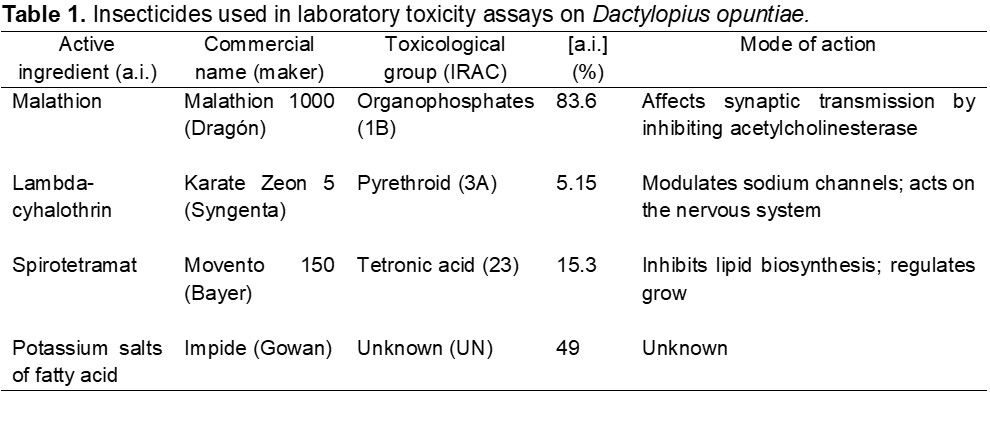Toxicity of four commercial insecticides on Dactylopius opuntiae (Hemiptera: Dactylopiidae)
DOI:
https://doi.org/10.56890/jpacd.v25i.481Palabras clave:
Prickly pear, nopal, Opuntia ficus-indica, cochineal, chemical control.Resumen
Dactylopius opuntiae (Cockerell) (Hemiptera: Dactylopiidae) is a pest of Opuntia ficus-indica (L.) Miller (Caryophyllales: Cactaceae) in many regions around the world, and there are no formal insecticide toxicity assays. This study aimed to evaluate the lethal toxicity of malathion, lambda-cyhalothrin, spirotetramat, and potassium salts on D. opuntiae in laboratory and greenhouse assays. In the laboratory, using a potter tower, lethal concentrations (LC50 and LC90) were determined on adult females. Under greenhouse conditions, on O. ficus-indica infested plants, the LC90 of those three conventional insecticides were evaluated, as well as the LC50 of potassium salts; mortality was evaluated 48 and 144 h after application in laboratory and greenhouse assays, respectively. D. opuntiae was susceptible to all insecticides; malathion was the most toxic product, LC50 120.4 mg L-1, lambda-cyhalothrin (159.8 mg L-1) and spirotetramat (756.3 mg L-1) followed. Using potassium salts, 8,970.1 mg L-1 were needed to achieve 50% mortality. The highest percentage of mortality (88.3%) in the greenhouse was obtained using the LC50 (8,970.1 mg L-1) of potassium salts and the LC90 of spirotetramat (11,567 mg L-1). Mortality caused by the LC90 of spirotetramat (77.3%) and malathion (66.8%) did not differ statistically; while the LC90 of lambda-cyhalothrin (11,427 mg L-1) caused 45.4% mortality, and it was the least toxic insecticide in the greenhouse assay. In this work, the toxicity of insecticides to improve their use against D. opuntiae is discussed.
##plugins.generic.pfl.publicationFactsTitle##
##plugins.generic.pfl.reviewerProfiles## N/D
##plugins.generic.pfl.authorStatements##
Indexado: {$indexList}
-
##plugins.generic.pfl.indexedList##
- ##plugins.generic.pfl.academicSociety##
- Journal of the Professional Association for Cactus Development
- Editora:
- Professional Association for Cactus Development




